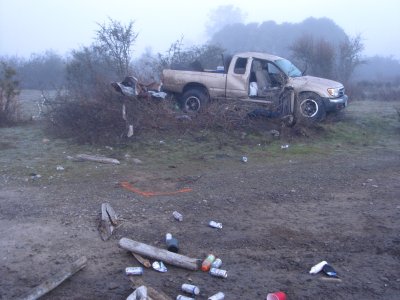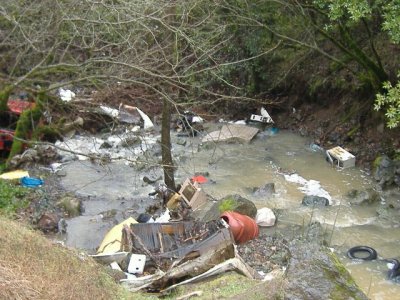LAKE COUNTY – The West Lake Conservation District has won a state grant that will help it complete assessments of three of the county's major watersheds.
Greg Dills, watershed coordinator, East Lake and West Lake Conservation Districts, said the West Lake District recently received a CALFED Watershed Committee grant of funds from Proposition 50, a state water bond.
The plan, said Dills, is to produce three watershed assessments for Middle Creek, Scotts Creek and Kelsey Creek, which will inventory historical and current data collected on the watersheds.
It was tough competition, said Dills; there were 120 applicants from agencies around the state that competed in a two-phased grant application process.
The district submitted a concept paper, Dills said, which explained its plan for the three assessments.
After making it past the first round of cuts, which took the number of applications down to 60, Dills said the district wrote a full proposal. The district, he said, was eventually named one of 28 projects funded statewide.
"It's highly competitive," said Dills. "We were fortunate to have done so well."
The watershed assessments the district proposes to complete will be a management tool, said Dills, and a building block in future work.
Once those planning documents are finished, he said, the district and/or its partners can use them to approach agencies for funds to pursue the projects identified in the assessments, such as restoration or fuel load reduction.
Together, Middle and Scotts Creeks are the most significant conveyance of water to Clear Lake, said Dills. They transport 57 percent of the water and 70 percent of sediment, he added.
The third largest watershed, said Dills, is Kelsey Creek.
The watersheds each have coordinated resource management and planning groups – called CRMPs – that have been meeting about the health of the county's watersheds, he said. For many years those groups have been compiling data and doing the background work necessary for watershed improvement projects.
“We've seen a lot of land use changes going on in the watersheds in recent years," said Dills, including shifts from agricultural usage to development, which impact watersheds.
The three watershed groups for Kelsey Creek, Middle Creek, and Scotts Creek, are now jumping into the assessment process, he said, which includes going into the Department of Public Works watershed data library, which stretches back to the 1940s.
That data, he said, includes loss of habitat, water quality data, fuel load management, stream bank erosion, nonnative and invasive weeds.
Dills said they'll identity missing data and try to fill in the gaps during the new assessment project.
There are many aspects to watershed management and assessments, said Dills. So, besides CRMP members examining data, there also will be help from engineers, hydrologists and other professionals in the watershed management field to help put the assessments together, "so we have the science behind it," he added.
There's a lot of work to be done, he said, and a deadline to do it by – June 2008 for assessment completion, with the grant expiring the following June.
Simultaneously, as the assessments are going on, said Dills, the Clear Lake Basin Management Plan will be completed under the grant. When the assessments are finished, he said, they will be incorporated into that finished management plan.
The grant also offers funds to provide capacity building for the Upper Cache Creek Watershed, said Dills. "Capacity building," said Dills, is a term used in reference to providing assistance and sustainability for the watershed groups, which includes training and educational workshops for watershed group members. Providing that assistance will be a function of the Upper Cache Creek Watershed Alliance, which was formed under this grant.
A few of those workshops have already taken place, he said. One, on Jan. 27 at the Scotts Valley Women's Clubhouse, was standing-room only, he said.
Interest in the health of watersheds – which has a direct impact on water quality – is interesting more people these days, Dills said.
"Back nine years ago when I started this whole journey, doing a kickoff meeting for a watershed group was a cold sell," he said.
He added, “This many years later, we have people coming in the office asking for help starting one.”
Education about water issues, and the success of local watershed groups, has helped generate the increased interest, he said. The Scotts Creek Watershed Council, he said, has been responsible for creek cleanups and a fire break on Cow Mountain.
The Big Valley CRMP, Lower Lake Watershed Council, Middle Creek CRMP, and Nice Watershed Group also participate in cleanup events each year removing thousands of cubic yards of trash from our landscape, according to Linda Juntunen, project coordinator for the West Lake Conservation District. The active groups are involved in a variety of projects and activities besides their cleanup events.
There are now nine CRMPs in various stages of activity throughout Lake County, Dills reported, with a 10th, in Lucerne, now beginning to form.
For more information about watershed issues, CRMPs and how to get involved, call the West Lake Resource Conservation District, 263-4180.
E-mail Elizabeth Larson at This email address is being protected from spambots. You need JavaScript enabled to view it..
{mos_sb_discuss:2}

 How to resolve AdBlock issue?
How to resolve AdBlock issue? 











